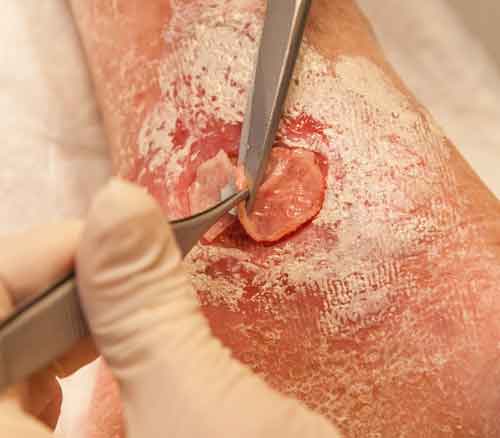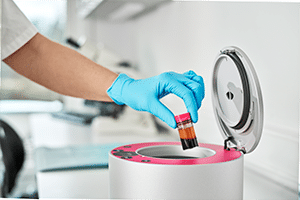Elaine Ricci
Clinical Lead Podiatrist
We asked Elaine to share her insights on the available treatment options for chronic wounds due to diabetes and the results her team has obtained with the 3C Patch® therapy.
CAN YOU TELL US ABOUT YOUR EXPERIENCE WORKING IN A SPECIALIST DIABETES FOOT CLINIC?
I have worked in the care of diabetes foot ulcers for 20 years. I clinically lead the Specialist Diabetes Podiatry team, both in the hospital and community. I coordinate care with the MDT (multidisciplinary diabetes team) and ensure the running of the weekly MDT clinic. In addition to this, I am the Deputy Chair of the Regional Diabetes Foot Network.
Personally, I see approximately 8 patients per day on the 4 days I work in the clinic. As a team, we have an inpatient caseload and see approximately 86 outpatients across the week.
FROM YOUR PERSPECTIVE, WHAT HAS CHANGED REGARDING THE TREATMENT STANDARDS FOR CHRONIC WOUNDS ASSOCIATED WITH DIABETES?
There has been a huge shift in managing the patient in a holistic way, and not just focusing on feet. Treatment in a diabetes foot clinic centers around three core concepts:
- Healing the foot
- Preventing avoidable amputation
- Reducing premature mortality associated with foot ulceration
The concepts around actual foot ulcer management have not seen dramatic changes in approach. The core concepts are the same: offload, control infection, assess blood supply, optimise glycaemic control.
There have been significant shifts, in the past 5 years, in the pathways into vascular services across the country, such as rapid access to vascular services by Podiatry teams, and closer integration across the community and acute services, resulting in better outcomes for patients.

HOW MANY OF THE DIABETES FOOT ULCER PATIENTS DO NOT RESPOND TO THE CONVENTIONAL STANDARD OF CARE TREATMENTS, AND WHAT LEADS TO THE DETERIORATION OF THE WOUNDS?
Approximately 5-10% of the patients we see do not heal using the best standard of care treatment, and they develop hard-to-heal wounds.
Other causes that lead to the chronicity of the diabetic foot ulcers are the limitations in vascular reconstruction options in some patients with tibial vessel disease.
Patients on dialysis may have also a higher probability of developing hard-to-heal foot ulcers.
IN ADDITION TO STANDARD OF CARE, WHAT OTHER TREATMENTS IS YOUR TEAM USING FOR CHRONIC WOUNDS DUE TO DIABETES?
We have a large variety of wound treatment options available to us, and we are an active site for clinical trials. We were a trial site for the 3C Patch® trial, and we are currently a trial site for MIDFUT in conjunction with the Leeds Clinical Trials Unit.
Other therapies available to us include sharp debridement, larvae therapy, negative pressure therapy, and hydrosurgical debridement. Most of these therapies can only be used in patients that have a good blood supply. Larvae therapy is a good, safe option for debridement in any patient where the blood supply is impaired.
We selected 3C Patch® as a treatment option in our clinic based on the experience and the results we obtained in the randomised clinical trial. We use 3C Patch® on patients where we have optimized all modifiable healing factors, and yet, their wound is still not progressing or is painfully slow to heal. In our experience, 3C Patch® has good results on these types of wounds, and also on wounds that are not healing due to reduced tissue perfusion – either from microvascular or macrovascular changes – where more aggressive forms of wound debridement are contraindicated. We consider that 3C Patch® is not an appropriate choice of treatment for a patient who is failing to heal due to issues of compliance.
All wounds where 3C Patch® is used must be safely de-sloughed so that the patch can be in physical contact with the wound bed. If it is not safe to do this, then the results of the 3C Patch® treatment will be suboptimal.

WHAT RESULTS HAVE YOU OBTAINED WITH 3C PATCH®?
So far, our team treated approximately 20 patients using the 3C Patch® therapy. The results we obtained are very good:
- 10 patients healed completely, with an average of 3 to 4 applications of the 3C Patch®.
- 8 patients showed significant signs of improvement,
- for 2 patients, the wounds showed minimal change.
We had a 66-year-old male patient who had 2 necrotic toes amputated. The patient had a history of PAD (peripheral arterial disease) and a score 3 according to SINBAD classification system (Site, Ischaemia, Neuropathy, Bacterial Infection, and Depth).
At 4 weeks post-op, the wound was making very slow progress and it showed signs of becoming chronic: the wound bed presented 50% slough and 50% pale granulation.
We managed all other modifiable factors and we decided to use 3C Patch®. After only 2 applications of the 3C Patch®, the wound showed sufficient progress, and we decided to continue only with the standard of care. The wound then healed completely within 2 weeks.
WHAT WOULD YOU CONSIDER TO BE THE MAIN BENEFIT OF USING 3C PATCH® FOR TREATING HARD-TO-HEAL DIABETIC FOOT ULCERS?
3C Patch® stimulates wound healing and restarts the healing process in chronic wounds. We have seen the effectiveness of the 3C Patch® in many different types of wounds, and is usually enough to use it until there is a combination of good enough quality granulation tissue, whereby you can see wound margin contracture and epithelialization. After this stage, the wound is sufficiently stimulated by the 3C Patch® treatment to continue to heal on its own.
